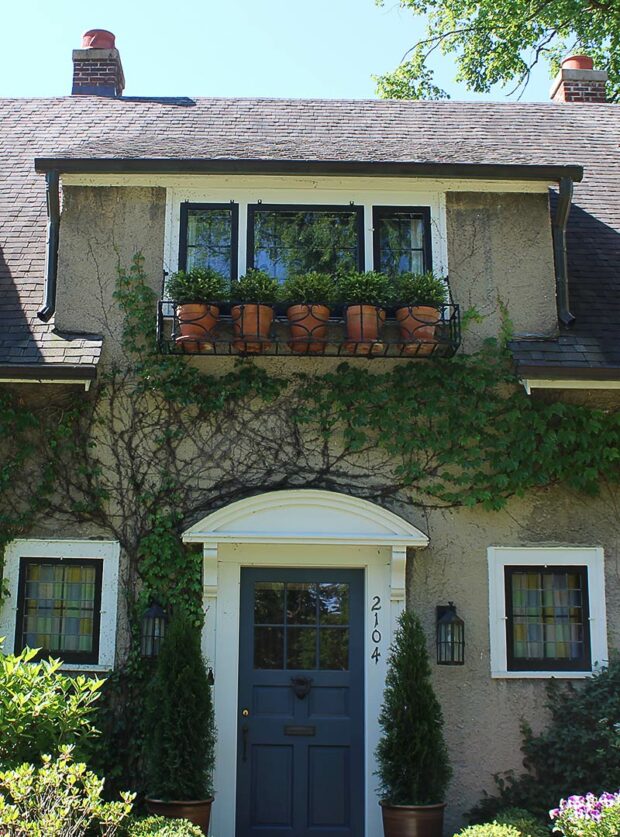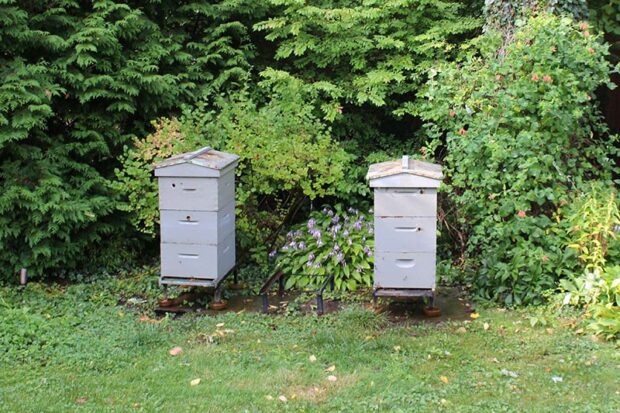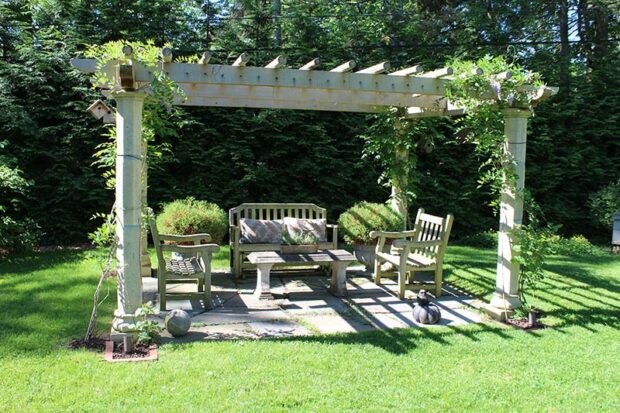
Chip and Betsy Erwin generously share the abundant harvest of vegetables and flowers from their superb vegetable garden.
Text and Photographs by Lisa Steinkopf
It isn’t often one sees a potager or kitchen garden in a front yard. Yet, Chip and Betsy Erwin have created a stunning one in the city limits of Ann Arbor.
I visited with Chip and asked him how this garden came to be in front of their home instead of in the backyard like most. He told me he and Betsy didn’t want to take up too much of their backyard with gardens, as it is quite shady. So, the sunny front yard became their food garden, and it is a showstopper.

Their home is circa 1926, while the garage is a newer addition. If you didn’t know, you couldn’t tell. Stone walls outline the potager and help moderate the temperature of the garden area. They had John Cullen of Celtic Gardens install the unique dry stack, mortarless stone walls. This type of wall construction has a history that dates to roughly 3800 BC. The walls are often seen in Scotland and England, as well as our New England states. They are befitting of the Erwin home. The metal window box above the front door was made by artist/ironsmith friend Andrew Kyte, of Kyte Metalwerks. It adds to the English cottage-like charm.

The front yard potager
The entrance from the sidewalk is my favorite aspect and I’m sure passersby would agree. It’s framed by an espaliered pear that curves over the front walk and forms a tunnel-like entrance. It highlights the garden and house beyond. A row of hardy Winter Gem boxwoods lines each side of the walk to the front door. The front walk has intersecting paths that lead to the side yard and driveway. These paths indicate the shade cast by the house—thus the foundation plantings are shade-tolerant.

The Erwin potager garden is quite a focal point in the neighborhood. Chip and Betsy say the garden’s greatest joy is the community aspect of the front garden. Many people stop to admire the garden while on their daily walks. So, Chip installed a garden bench around the street tree so people can have a place to rest as they admire the garden.
The Erwins share the bounty of the garden with everyone, leaving bouquets on the bench. They make pairs so neighbors not only get a bouquet for themselves but one to share with a friend. In the fall, children love to stop to see the pumpkins hanging from the pear trellis. It’s unusual to see a pumpkin hanging from a trellis. Chip and Betsy have received many thank-you notes in return for their generous gifts. The neighborhood sharing has brought other surprises: new recipes. A neighbor used the Honeycrisp and Gala apples to make an apple curry chutney from a family recipe in India. A neighbor from Kenya, missing the collard greens of her youth, shared her recipe and was able to partake in their abundant harvest.

The garden is filled with many different vegetables, herbs, perennials, and annuals. The Erwins start over half of what they grow from seed. The list includes tomatoes, collards, cucumbers, Swiss chard, and more. Lettuce, radishes, and carrots are planted in succession, so they are always available.
Chip likes to try new plants each year. He has grown cardoons, tomatillos, and walking onions. The bounty from their garden is not only shared, but also canned and frozen for later. They make salsa from the tomatoes and dry their herbs for winter recipes. They are dried in the oven on low until the leaves fall from the stems. Rosemary, thyme, and parsley are ground in the coffee grinder and stored. He finds overplanting teaches what plants do the best. If they do well, they stay. If not, they go to the compost pile. There are perennials planted around the edges and some plants are grown on obelisks to allow room for more plants. Sweet autumn clematis, sweet peas, and clematis are some of the vines in the garden. Pies and jam are the results of the rhubarb harvest as well as a simple syrup for cocktails.

The Erwins have also included a pollinator garden for the butterflies and bees. Not only do they grow plants for the bees, but they also “grow” bees. They have two beehives in the backyard and together the neighborhood boasts six hives. They harvest honey twice a year, both in the early summer and late summer. This leaves enough for the bees for the winter. I was lucky enough to receive a jar of that honey. Yum!
Many of their plants have a story. They received indigo from their brother-in-law, a maidenhair fern from Betsy’s mom, and lupines from an aunt in Maine. Shared family plants are the best.
They have many dahlias, and over the winter they are stored in the garage in light wood chips. A tender fig tree also enjoys the garage all winter. Because there is a living space over the garage, it stays warm enough to keep the plants through the winter without freezing.
I’m sure you are wondering, as I did, how Chip and Betsy keep the deer from decimating the garden. They have motion sensor sprayers that are on at night. Of course, they are off during the day to prevent unscheduled showers while gardening. The most damaging pests are the resident groundhogs. The challenge is preventing them from not only eating their garden but also ruining the stone walls.

The backyard garden
As we move to the backyard, the light becomes shady but there is one area that isn’t. Here, Chip and Betsy incorporated raised beds for more vegetables and herbs. The beds are three large water troughs usually used for farm animals. One is dedicated to herbs, including mint, rue, chives, sage, and rosemary. The rosemary moves to the garage in the fall and grows under lights to extend the harvest. Kale fills another trough, which they cover to keep the cabbage moths away. The third has radishes, snow peas, and nasturtiums. These are right off the patio, and easily accessible to the kitchen. Chip says these troughs are a great idea for people that don’t have a lot of room for gardening. Each one supplies a lot of food. The raised aspect is also great for people who cannot garden the usual way. After back surgery, I can understand! Raised beds are ideal for many.

There is a small fenced-in area filled with plants. Originally, it was home to chickens for several years. Unfortunately, neighbors complained of chicken “leftovers” on their patios and porches. Thus, the free-range chickens found new homes. The Erwins let the ground sit for a year. Now the nitrogen-rich area is home to asparagus, Turkish rocket, and other plants.


The backyard pergola supports many vines, including wisteria, hops, trumpet vine, and a rose. It is a wonderful place to rest in the summer and enjoy the bees, butterflies, and (faux) sheep.
I had a wonderful time talking to Chip and Betsy about their amazing garden. I love how it has drawn in the community. Their generosity in sharing flowers and the edible bounty of their garden is heartwarming. What a great example to follow in our own gardens!
Lisa Steinkopf is The Houseplant Guru. Check out her website and blog at www.thehouseplantguru.com. Contact Lisa to speak at your next club meeting or event (houseplantgurulisa@gmail.com or 734-748-1241). Follow her on Facebook (Facebook.com/HouseplantGuru), Twitter (@houseplantguru), and Instagram (houseplantguru).

Leave a Reply